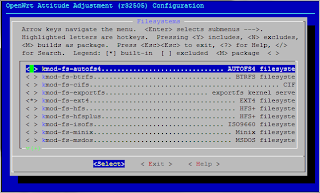Introduction
JUNOS supports NETCONF protocol which is XML-RPC based mechanism to communicate
with router/firewalls (any thing that runs JUNOS). Get information to and from the JUNOS,
Upgrade devices remotely. Make applications either web based or right on the JUNOS device.
I am rather interested in some thing new, as I like SNMP protocol and have built many web based applications for monitoring and configuring devices, gathering statistics for network planning and other useful stuff. I am interested in a web based NETCONF application because if you want to transport a VLAN over a network from point A to point B, it does not make sense of making scripts on individual JUNOS device but make a script on a central server which then deploys it to each and every device in-path.
Juniper's CLI is a itself client to NETCONF protocol.
NETCONF
Mgd daemon is responsible for the NETCONF procotol. JUNOS runs NETCONF over ssh,
lets enable the ssh procotol.
[edit]
root# set system services ssh
[edit]
root# set system services netconf ssh
[edit]
root# set system services netconf ssh
now access a linux machine and execute the following command
root@nms:~# ssh root@192.168.3.4 -s netconf
root@192.168.3.4's password:
root@192.168.3.4's password:
JUNOS will reply like the following,
<!-- No zombies were killed during the creation of this user interface -->
<!-- user root, class super-user -->
<hello>
<capabilities>
<capability>urn:ietf:params:xml:ns:netconf:base:1.0</capability>
<capability>urn:ietf:params:xml:ns:netconf:capability:candidate:1.0</capability>
<capability>urn:ietf:params:xml:ns:netconf:capability:confirmed-commit:1.0</capability>
<capability>urn:ietf:params:xml:ns:netconf:capability:validate:1.0</capability>
<capability>urn:ietf:params:xml:ns:netconf:capability:url:1.0?protocol=http,ftp,file</capability>
<capability>http://xml.juniper.net/netconf/junos/1.0</capability>
<capability>http://xml.juniper.net/dmi/system/1.0</capability>
</capabilities>
<session-id>4509</session-id>
</hello>
]]>]]>
XML output shows the connection is established and JUNOS has just welcomed you to it's NETCONF interface.
execute a command and see what JUNOS replies, paste the following into same sshd session
<rpc message-id="1" xmlns="urn:ietf:params:xml:ns:netconf:base:1.0">
<get-system-uptime-information/>
</rpc>
<get-system-uptime-information/>
</rpc>
The above command retrieves information from the device about the uptime of the JUNOS access via ssh.
<rpc-reply xmlns="urn:ietf:params:xml:ns:netconf:base:1.0" xmlns:junos="http://xml.juniper.net/junos/9.1R2/junos" message-id="1" xmlns="urn:ietf:params:xml:ns:netconf:base:1.0">
]]>]]><system-uptime-information xmlns="http://xml.juniper.net/junos/9.1R2/junos">
<current-time>
<date-time junos:seconds="1366935506">2013-04-26 00:18:26 UTC</date-time>
</current-time>
<system-booted-time>
<date-time junos:seconds="1366933535">2013-04-25 23:45:35 UTC</date-time>
<time-length junos:seconds="1971">00:32:51</time-length>
</system-booted-time>
<protocols-started-time>
<date-time junos:seconds="1366933734">2013-04-25 23:48:54 UTC</date-time>
<time-length junos:seconds="1772">00:29:32</time-length>
</protocols-started-time>
<last-configured-time>
<date-time junos:seconds="1366933868">2013-04-25 23:51:08 UTC</date-time>
<time-length junos:seconds="1638">00:27:18</time-length>
<user>root</user>
</last-configured-time>
<uptime-information>
<date-time junos:seconds="1366935506">
12:18AM
</date-time>
<up-time junos:seconds="2001">
33 mins
</up-time>
<active-user-count junos:format="1 user">
1
</active-user-count>
<load-average-1>
0.16
</load-average-1>
<load-average-5>
0.03
</load-average-5>
<load-average-15>
0.03
</load-average-15>
</uptime-information>
</system-uptime-information>
</rpc-reply>
]]>]]>
]]>]]><system-uptime-information xmlns="http://xml.juniper.net/junos/9.1R2/junos">
<current-time>
<date-time junos:seconds="1366935506">2013-04-26 00:18:26 UTC</date-time>
</current-time>
<system-booted-time>
<date-time junos:seconds="1366933535">2013-04-25 23:45:35 UTC</date-time>
<time-length junos:seconds="1971">00:32:51</time-length>
</system-booted-time>
<protocols-started-time>
<date-time junos:seconds="1366933734">2013-04-25 23:48:54 UTC</date-time>
<time-length junos:seconds="1772">00:29:32</time-length>
</protocols-started-time>
<last-configured-time>
<date-time junos:seconds="1366933868">2013-04-25 23:51:08 UTC</date-time>
<time-length junos:seconds="1638">00:27:18</time-length>
<user>root</user>
</last-configured-time>
<uptime-information>
<date-time junos:seconds="1366935506">
12:18AM
</date-time>
<up-time junos:seconds="2001">
33 mins
</up-time>
<active-user-count junos:format="1 user">
1
</active-user-count>
<load-average-1>
0.16
</load-average-1>
<load-average-5>
0.03
</load-average-5>
<load-average-15>
0.03
</load-average-15>
</uptime-information>
</system-uptime-information>
</rpc-reply>
]]>]]>
]]>]]> is used to represent the end of XML-RPC message, this will normally always be used in request/response messages.
The above XML reply can be formatted to display it in more readable format, which can be done using any XML parser.
Thank You,
Thank You,














